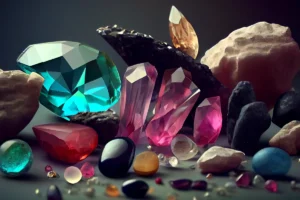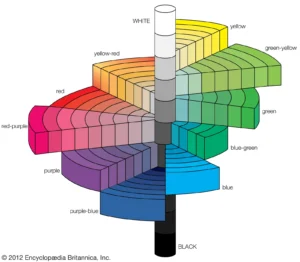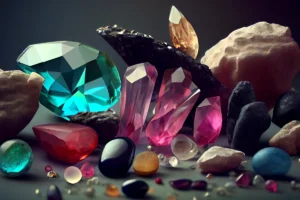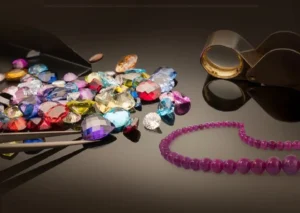Color is one of the most important factors influencing a gemstone’s beauty, rarity, and value. Unlike diamonds, where clarity and cut often take precedence, colored gemstones are primarily graded based on their hue, tone, and saturation.
Understanding how gemstone color grading works helps buyers, collectors, and investors make informed decisions. This article explores the key aspects of gemstone color grading, the industry standards used, and how different factors influence a gemstone’s color and value.
Gemstone Color Grading Explained

1. The Three Key Components of Gemstone Color
Gemologists evaluate gemstone color based on three primary characteristics:
a. Hue (Basic Color)
Hue refers to the dominant color of the gemstone, which is often modified by secondary colors. The most desirable gemstones exhibit pure hues with minimal secondary tones.
- Primary Hues – Red, orange, yellow, green, blue, violet, and purple.
- Secondary Hues – Additional color tints that influence the main hue, such as a bluish-green emerald or a purplish-red ruby.
- Pure Hue Stones – Gemstones with a single, strong color (e.g., vivid red rubies) are typically more valuable than stones with noticeable secondary hues.
b. Tone (Lightness or Darkness)
Tone describes how light or dark a gemstone appears, ranging from very light to very dark.
- Very Light (1-2) – Almost transparent with a barely visible color.
- Light (3-4) – Pastel shades with some vibrancy.
- Medium (5-6) – Well-balanced color intensity, typically the most desirable.
- Dark (7-8) – Rich, deep colors but still retains some transparency.
- Very Dark (9-10) – Nearly opaque, often reducing gemstone brilliance.
c. Saturation (Intensity of Color)
Saturation refers to the purity and intensity of a gemstone’s color. Higher saturation results in a more vibrant gemstone, while lower saturation appears dull or washed out.
- Low Saturation – Muted or grayish tones reduce desirability.
- Moderate Saturation – Still vibrant but may contain slight gray or brown undertones.
- High Saturation – Pure, vivid color with no dulling influences, often the most valuable.
2. Industry Standards for Color Grading
Several gemological institutions have developed color grading systems for consistency in evaluating gemstones:
a. Gemological Institute of America (GIA)
- The GIA uses a hue-tone-saturation model to grade colored gemstones.
- Color is described using terms like “Vivid Blue,” “Medium Intense Green,” or “Deep Red.”
- GIA reports include precise descriptions but do not assign numerical grades.
b. American Gemological Laboratories (AGL)
- AGL provides a numerical grading scale to define gemstone color quality.
- Uses a 1 to 10 scale for tone and saturation.
- Premium gemstones receive labels such as “Exceptional,” “Fine,” or “Commercial.”
c. World Colored Stone Association (ICA)
- Emphasizes visual assessment of hue, tone, and saturation.
- Uses descriptive words rather than numerical scales.
3. Color Grading in Specific Gemstones
Different gemstones have unique color preferences and grading considerations.
a. Rubies (Red Corundum)
- The most valuable rubies are “Pigeon’s Blood Red”, a pure, vivid red with no brown or purple undertones.
- Overly dark or pinkish rubies may have lower market value.
b. Sapphires (Blue Corundum)
- Highly prized sapphires are “Royal Blue” or “Cornflower Blue”, exhibiting deep but bright hues.
- Grayish or overly dark sapphires are considered less valuable.
c. Emeralds (Green Beryl)
- The most valuable emeralds are “Vivid Green” with no excessive yellow or blue hues.
- Clarity plays a significant role in emerald valuation alongside color.
d. Fancy Colored Diamonds
- Unlike colorless diamonds, fancy-colored diamonds (e.g., pink, yellow, or blue) are valued based on color intensity.
- The Fancy Vivid grade is the most expensive, followed by Fancy Intense, Fancy, and Fancy Light.
4. Factors That Influence Gemstone Color
Several factors impact how a gemstone’s color appears and its overall valuation:
- Lighting Conditions – Natural daylight reveals true color, while artificial lighting can alter perception.
- Cut and Shape – A well-cut gemstone enhances color depth, while a poorly cut stone may appear dull.
- Origin – Certain sources are known for superior colors (e.g., Burmese rubies, Colombian emeralds, Kashmir sapphires).
- Treatments and Enhancements – Heat treatment, dyeing, or irradiation can modify color, affecting price.
5. Choosing the Right Gemstone Color for Jewelry and Investment
When selecting a gemstone, consider the following:
- For Jewelry – Choose a color that complements your skin tone and personal style.
- For Investment – Look for high saturation, balanced tone, and minimal secondary hues.
- For Rarity – Unheated, naturally vibrant stones tend to appreciate in value more than treated ones.
Gemstone color grading is a critical aspect of determining quality and value. Understanding the nuances of hue, tone, and saturation allows buyers to make confident purchasing decisions.
Whether investing in high-end rubies, sapphires, or emeralds, or simply selecting a gemstone for personal enjoyment, knowing how color impacts beauty and worth ensures a well-informed choice.




